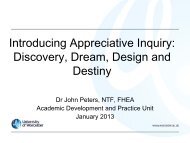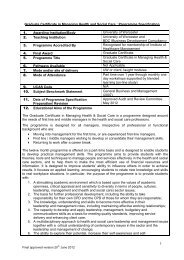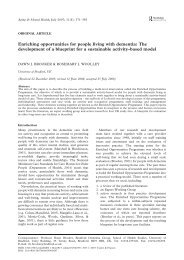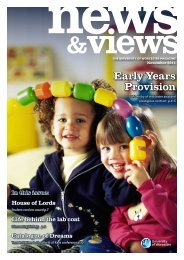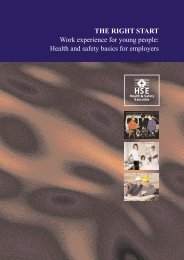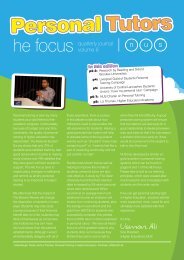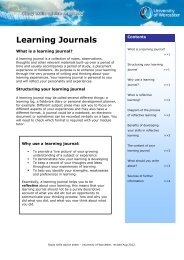Including children with cerebral palsy in mainstream physical
Including children with cerebral palsy in mainstream physical
Including children with cerebral palsy in mainstream physical
You also want an ePaper? Increase the reach of your titles
YUMPU automatically turns print PDFs into web optimized ePapers that Google loves.
Hilderley & Rh<strong>in</strong>d<br />
<strong>Includ<strong>in</strong>g</strong> <strong>children</strong> <strong>with</strong> cp <strong>in</strong> <strong>physical</strong> education<br />
socialization <strong>with</strong> peers were identified as key narratives related to the PE<br />
experience.<br />
Further qualitative research has been conducted by Spencer-Cavaliere and<br />
Watk<strong>in</strong>son (2010). Semi-structured <strong>in</strong>terviews were undertaken <strong>with</strong> 11 <strong>children</strong><br />
aged between 8-12 years old. The <strong>children</strong> had disabilities which <strong>in</strong>cluded CP, f<strong>in</strong>e<br />
and gross motor delays and muscular dystrophy. Content analysis highlighted the<br />
importance of ga<strong>in</strong><strong>in</strong>g entry to play, feel<strong>in</strong>g like a legitimate participant and hav<strong>in</strong>g<br />
friends. The actions of other people were identified as a key determ<strong>in</strong>ant of the<br />
degree to which effective <strong>in</strong>clusion was achieved. It is important to build on this<br />
research to take a more holistic approach through also <strong>in</strong>clud<strong>in</strong>g the perspectives of<br />
the teachers and support workers.<br />
AIMS<br />
The present study explores the perceptions of adolescents <strong>with</strong> CP, their teachers,<br />
and support staff regard<strong>in</strong>g <strong>in</strong>clusion <strong>in</strong> PE <strong>in</strong> a ma<strong>in</strong>stream school. Two specific<br />
research questions were identified. Firstly, what are the perceived benefits of PE for<br />
pupils <strong>with</strong> CP Secondly, what are the potential barriers to <strong>in</strong>clud<strong>in</strong>g pupils <strong>with</strong> CP<br />
<strong>in</strong> PE<br />
The need for this research can be justified on a number of grounds. Firstly, there is a<br />
lack of research which specifically addressed this topic <strong>with</strong><strong>in</strong> this population.<br />
Secondly, related research has tended to focus on <strong>children</strong> <strong>with</strong> mild disabilities, as<br />
highlighted by Vogler et al., (2000). The present study considers <strong>children</strong> <strong>with</strong><br />
moderate or severe CP. Thirdly, exist<strong>in</strong>g research tended to focus on the<br />
perceptions of teachers and thus, neglected the views of the child (Graham, 1995).<br />
Although some research <strong>in</strong>cluded <strong>children</strong>, the experiences of adolescents received<br />
little attention (Rimmer, 2001). F<strong>in</strong>ally, related research has been criticized for<br />
focus<strong>in</strong>g on the disability itself rather than the broader context (Hemm<strong>in</strong>gson &<br />
Borrel, 2002). The present study, therefore, adheres to the recommendation of the<br />
World Health Organization (1999) through adopt<strong>in</strong>g a more holistic approach to also<br />
consider contextual factors. Through such research it may be possible to advocate<br />
changes which promote the benefits and help overcome the barriers faced by<br />
adolescents <strong>with</strong> CP.<br />
METHOD<br />
Participants<br />
The eight participants were three pupils <strong>with</strong> CP (Jo, Sam, and Ali), two teachers and<br />
three support workers. Jo is 22 and has spastic quadriplegia and uses an electric<br />
wheelchair. She f<strong>in</strong>ds it difficult to grip objects and to perform delicate tasks such as<br />
pa<strong>in</strong>t<strong>in</strong>g. Jo has poor balance as well as limited trunk control and leg movement.<br />
Sam is 20 and has spastic diplegia. Sam has perfect movement <strong>in</strong> the arms, but has<br />
difficulty mov<strong>in</strong>g his legs. He can move around us<strong>in</strong>g walk<strong>in</strong>g sticks. Ali is 18 and has<br />
athetoid dystonic, which affects all limbs but particularly those on the right side. He<br />
has very limited weight bear<strong>in</strong>g on the right side. Ali uses an electric wheelchair. The<br />
support workers helped these students <strong>in</strong> <strong>physical</strong> education, usually on a one-onone<br />
basis. The students’ activity levels varied from only participat<strong>in</strong>g <strong>in</strong> sport <strong>in</strong> PE<br />
lessons to elite level participation (<strong>in</strong> sail<strong>in</strong>g). All of the students had diagnosed<br />
© 2012 GJSEPER 4



